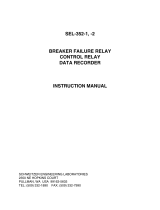
3. Impedance protection
Full-scheme distance measuring, Mho
characteristic ZMHPDIS (21)
The numerical mho line distance protection is a
zone full scheme protection for back-up detection
of short circuit and ground faults. The zones have
fully independent measuring and settings, which
gives high flexibility for all types of lines.
The IED can be used up to the highest voltage
levels. It is suitable for the protection of heavily
loaded lines and multi-terminal lines where the
requirement for tripping is one-, two- and/or three-
pole.
Full-scheme distance protection, quadrilateral for
earth faults ZMMPDIS, ZMMAPDIS (21)
The distance protection is a five zone protection
with three fault loops for phase-to-ground fault for
each of the independent zones. Individual settings
for each zone resistive and reactive reach give
flexibility for use on overhead lines and cables of
different types and lengths.
The Full-scheme distance protection, quadrilateral
for earth faults functions ZMMDPIS (21) and
ZMMAPDIS (21) have functionality for load
encroachment, which increases the possibility to
detect high resistive faults on heavily loaded lines .
The independent measurement of impedance for
each fault loop together with a sensitive and reliable
built in phase selection makes the function suitable
in applications with single phase auto-reclosing.
The distance protection zones can operate,
independent of each other, in directional (forward or
reverse) or non-directional mode. This makes them
suitable, together with different communication
schemes, for the protection of power lines and
cables in complex network configurations, such as
parallel lines, multi-terminal lines.
Directional impedance element for Mho
characteristic ZDMRDIR
The phase-to-ground impedance elements can be
optionally supervised by a phase unselective
directional function (phase unselective, because it is
based on symmetrical components).
Mho impedance supervision logic ZSMGAPC
The Mho impedance supervision logic (ZSMGAPC)
includes features for fault inception detection and
high SIR detection. It also includes the functionality
for loss of potential logic as well as for the pilot
channel blocking scheme.
ZSMGAPC can mainly be decomposed in two
different parts:
1. A fault inception detection logic
2. High SIR detection logic
Faulty phase identification with load encroachment
FMPSPDIS (21)
The operation of transmission networks today is in
many cases close to the stability limit. Due to
environmental considerations the rate of expansion
and reinforcement of the power system is reduced,
for example difficulties to get permission to build
new power lines. The ability to accurate and reliable
classifying the different types of fault so that single
phase tripping and autoreclosing can be used plays
an important roll in this matter.
The phase selection function is design to accurately
select the proper fault loop(s) in the distance
function dependent on the fault type.
The heavy load transfer that is common in many
transmission networks may in some cases interfere
with the distance protection zone reach and cause
unwanted operation. Therefore the function has a
built in algorithm for load encroachment, which
gives the possibility to enlarge the resistive setting
of the measuring zones without interfering with the
load.
The output signals from the phase selection
function produce important information about faulty
phase(s), which can be used for fault analysis as
well.
Power swing detection ZMRPSB (68)
Power swings may occur after disconnection of
heavy loads or trip of big generation plants.
Line distance protection REL670 ANSI
1MRK 506 317-BUS A
Pre-configured
Product version: 1.2
12 ABB






















